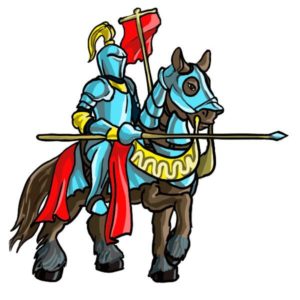 As a horse lover, I haven’t yet found any form of equine entertainment I don’t enjoy except “Big Lick” Tennessee Walking Horse events, which is a subject for a whole different column. I love watching polo. I love watching Clydesdales pull the Budweiser wagon. I love watching the Kentucky Derby. Most of all, I love watching rodeos.
As a horse lover, I haven’t yet found any form of equine entertainment I don’t enjoy except “Big Lick” Tennessee Walking Horse events, which is a subject for a whole different column. I love watching polo. I love watching Clydesdales pull the Budweiser wagon. I love watching the Kentucky Derby. Most of all, I love watching rodeos.
But until last month, I’d never watched a real jousting match.
That’s one reason I was excited to attend the Tennessee Renaissance Festival in Arrington. In last week’s column, I wrote about some of the fascinating things I saw at the festival. I didn’t, however, write about jousting because it deserves a column all its own.
Jousting contests began during the Middle Ages as a way to keep knights and their horses in shape in between battles. Jousting is often called history’s first extreme sport. Jousters were the star athletes of their day and “freelancers”—knights not bound to a master and therefor free to fight for the highest bidder—were typically the cream of the crop. Jousting quickly became not just a fitness activity but also a form of entertainment. It remained popular until the 16th century, when the development of firearms sharply diminished the need for knights.
Today, of course, jousting is pure entertainment provided by aficionados who travel the Renaissance Festival circuit. The troupe I witnessed—The Free Lancers—was skilled and immensely entertaining.
Modern-day jousters, like their centuries-old counterparts, ride draft horses. Draft horses were and are primarily bred to pull heavy equipment but are also prized under saddle for their athletic abilities and calm, gentle dispositions. One breed the jousters ride is Shire horses, the biggest horses in the world. A Shire named Mammoth, born in 1848, was more than 21 hands (seven feet!) high and weighed 3,300 pounds. Like Clydesdales, Shires are known for their leg feathers—long strands of hair that cascade from knees to hooves. Percherons are the other breed jousters use. They don’t have leg feathers and are typically not as big as Shires, but they’re also docile and willing.
In modern-day jousting contests, knights earn points by capturing a series of rings with their lance, by hitting the shield of their opponent with the lance and—of course—by knocking the opposing rider off his horse. I didn’t witness an “unseating” at the Tennessee Renaissance Festival. I’m still trying to decide if I’m relieved or disappointed.
My take-away after my first experience as a jousting spectator? No way do I want to be a participant. For one thing, I’m too little to ride a horse whose withers are a foot higher than the top of my head. For another, I’m too hot-natured to wear a suit of armor. And last but certainly not least, I have no interest in being intentionally knocked off a horse, especially a gigantic one. Seven feet is a long way to fall.
(June 2, 2019)